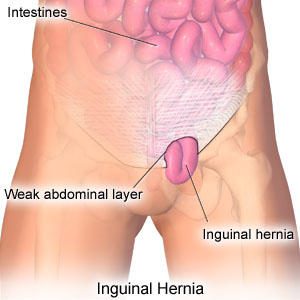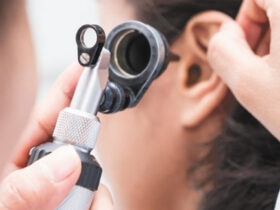Minimally Invasive Technology Transforms the Way Doctors Perform This Surgery
By Gary M. Bunch, M.D., F.A.C.S. –
 What is a Hernia?
What is a Hernia?
The word Hernia means ‘something coming through.’ A hernia is simply a hole through which something can protrude, usually intestine or the fat around the intestine. It is the swelling or lump that is there when you stand or cough which goes away when you lie down. This is the most common and obvious sign of a hernia.
The most common location for a hernia is the abdomen. The abdominal wall holds in the abdominal contents, primarily the intestines. If a weakness should open up in that wall, then what pushes against it from the inside (the intestines) simply pushes through the window. The ensuing bulge, often visible against the skin, is the hernia and is a potentially serious problem.
Both men and woman can get hernias and they can develop at any age. Hernias may result from birth defects, previous incisions, heavy lifting, obesity, pregnancy, persistent coughing, or straining with bowel movements.
How Do You Know if You Have a Hernia?
If you have pain directly in the muscle of the stomach, feeling sore to the touch when you press on it, then it is more likely you have sprained or strained this muscle. This commonly occurs because of vigorous exercise or vigorous physical activity, such as lifting heavy objects.
Intestinal or abdominal pain is deeper and more aching in character, whereas muscle pain is more superficial. A hernia generally presents as soreness in the groin. There may also be a bulge or a swelling in the groin or, if you are male, in the scrotum. Often the bulge can be made larger by straining the abdominal muscles.
Hernias in adults do not get better or simply go away. The hernia will almost certainly enlarge with time, becoming more of a problem. Any symptoms, such as discomfort and pain will also worsen, affecting your quality of life and ability to work. Delaying surgical repair and allowing the hernia to enlarge could make the later operation more complicated when you do eventually have surgery. There is always the possibility of strangulation (approximately 5%), where the bowel becomes trapped in the hernia and loses its blood supply, requiring emergency surgery.
Types of Hernia
The most common hernia is the Inguinal or Groin hernia and can occur on the left, right or both sides of the lower abdomen. Surgical repair of the Inguinal hernia is extremely common with over 600,000 cases being performed in the United States.
A Hiatal or Diaphragmatic hernia develops in a small opening in the diaphragm where the esophagus or food pipe joins to the stomach. A Hiatal hernia allows part of the stomach to move up into the chest and stomach acid can flow back into the esophagus causing heartburn.
Umbilical hernias occur in and around the belly button or naval. They are usually present from birth but may not be noticed until later in childhood or even into adulthood. While Umbilical hernias in infants usually close without any intervention, this is not the case in adults. Over time they tend to enlarge and become more problematic.
Minimally Invasive Repair of Hernias
Minimally invasive technology and techniques are transforming the way many doctors perform surgery. In the past, open surgery was the only option available when doctors needed to see inside a patient’s body or remove or repair organs or tissue. Patients who have conventional open surgery typically face large incisions, significant hospital stays, lengthy recoveries and the risk of complications. That’s no longer the case. Today, surgeons make small incisions or “ports” and perform minimally invasive procedures whenever possible. These procedures can accomplish the same results as traditional surgery but can be much less traumatic to patients.
At Bradenton Surgical Group, we use minimally invasive surgery to repair most hernias. In a laparoscopic hernia repair procedure, our surgeons will make several tiny incisions (each about the size of a pencil eraser) through which they insert surgical instruments and a small video camera. Our surgeons are then able to locate the hernia and surgically close the weak area using a prosthetic mesh. The mesh reinforces the area of weakness and reduces the tension on the repair. A tension free repair is less likely to allow the hernia to reoccur.
The advantage of this laparoscopic approach over more traditional open methods is that because the incisions are much smaller than traditional methods, there is less discomfort and faster recuperation. Also, it is often possible to repair bilateral hernias (those on the left and the right of the abdomen) during a single procedure using laparoscopic methods.
A Full Range of Minimally Invasive Procedures
We offer a full range of minimally invasive procedures that address problems in nearly every part the body. In addition to Hernia surgery, some of the most common procedures we perform are: Abdominal, Colorectal, Hemorrhoid, Adrenal and Parathyroid Surgery. To learn more about Hernia or any of the procedures we provide, please call Bradenton Surgical Group at 941-744-2700 or visit us online at www.bradentonsurgicalgroup.com.










